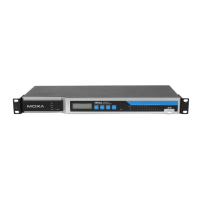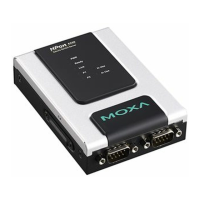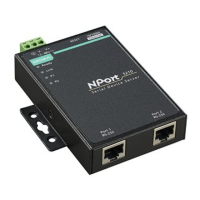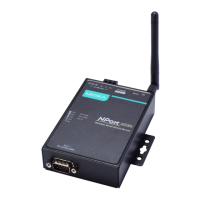
Do you have a question about the Moxa Technologies NPort 6650 and is the answer not in the manual?
| Brand | Moxa Technologies |
|---|---|
| Model | NPort 6650 |
| Category | Server |
| Language | English |
The NPort 6000 network enables traditional serial (RS-232/422/485) devices.
Each NPort 6000 serial device server is shipped in a separate box, which also includes a number of standard accessories.
All models in the NPort 6000 series have the following features.
The following table shows the main differences between the NPort 6000 models:
NPort 6150, NPort 6250, NPort 6450, and NPort 6610/6650 specifications.
Diagrams showing the panel layout for NPort 6150/6250, NPort 6450, and NPort 6610/6650.
Instructions for wall, DIN-rail, and rack-mounting the NPort 6000 series.
This section describes how to connect the NPort 6000 to serial devices for the first time.
Determine whether your NPort 6000 needs to use a static IP or dynamic IP address.
The NPort 6000 is configured with the default private IP address: 192.168.127.254.
Options for configuring the NPort 6000's IP address: Device Search Utility, Web Console, LCM Console.
The NPort 6000 network enables traditional serial (RS-232/422/485) devices.
Each serial port is independently configurable for a different mode with different settings.
Modes for device-control: Real COM/Secure Real COM mode and RFC2217 mode.
Modes for socket applications: TCP Server/Secure TCP Server, TCP Client/Secure TCP Client, and UDP.
Mode to remove the 15-meter distance limitation imposed by the RS-232 interface.
Designed for legacy OS not supporting TCP/IP Ethernet.
Connect terminals to UNIX or Windows servers over a network.
Manage connection between a terminal and a server with reversed roles.
Provides a solution for banking and stock exchange services with huge printing demands.
Provides dial-in/dial-out access for ISPs and enterprises needing remote access.
You can disable any port on the NPort 6000 by setting the operation mode to Disabled.
Verify that cookies are enabled for your browser. If the cookies are disabled, you will not be able to use the web console.
The left panel is the navigation panel with an expandable menu tree for navigating settings.
Assign the NPort 6000 IP address, netmask, Gateway, and other IP parameters.
Setting up Ethernet Redundancy on your NPort 6000 network.
Moxa developed the proprietary Turbo Ring protocol to optimize communication redundancy.
Each serial port on the NPort 6000 can be configured independently.
For Real COM Mode/Reverse Real COM Mode, to reconfigure the settings for a particular serial port.
TCP Server Mode, TCP Client Mode, and UDP Mode.
Mode to remove the 15-meter distance limitation imposed by the RS-232 interface.
The NPort 6000 accepts the AT command ATD IP address: TCP port.
Terminal ASCII (TERM_ASC), Terminal BIN (TERM_BIN), and SSH modes.
Reverse Telnet Mode and Reverse SSH Mode.
RAW PRN Mode and LPD PRN Mode.
PPP Mode, PPPD Mode, SLIP Mode, SLIPD Mode, and Dynamic Mode.
You can disable any port on the NPort 6000 by setting the operation mode to Disabled.
Serial Parameters for configuring baud rate, data bits, stop bits, parity, and flow control.
Configure port buffering to prevent loss of serial data when the Ethernet connection is down.
Modem settings for Dial In/Out modes.
Choose cipher priority for SSL and SSH to build secure connections.
Authenticate users for terminal or reverse terminal access.
Enable and enter a welcome message to greet dial-in or terminal users.
Configure Server Settings and Time Settings.
Use IP address-based filtering to control access to serial ports.
Simplify IP address entry by assigning a Host Name to a Host IP Address.
Upgrade the NPort 6000’s firmware through the web console, serial console, or NPort Search Utility.
Export and import configuration settings to a file.
Import Ethernet SSL/TLS certificates for HTTPS/SSH/Secure OP modes.
Manage user accounts, groups, and password policies.
Enable and configure the SNMP Agent function.
Configure RADIUS and TACACS+ servers for user authentication.
Configure console access methods (HTTP/HTTPS, Telnet/SSH, Moxa Service).
Reset all NPort 6000 settings to factory default values.
Customize network events that are logged by the NPort 6000.
Assign a remote Log Server in the System Management / Misc. Network Settings.
View Serial Status and System Status to monitor device and network information.
Configure notifications for system, network, and configuration events.
Ping an IP address from the NPort 6000 web console to test the Ethernet connection.
Change the password for the NPort 6000 device.
Save submitted configuration changes to the NPort 6000’s flash memory.
Restart the NPort 6000 system or its ports.
Terminate the session of the current account.
The CD includes NPort Windows Driver Manager, Device Search Utility, User Manual, and firmware upgrade utility.
Map unused COM ports on your PC to serial ports on the NPort 6000.
Locate all NPort 6000 servers connected to the same LAN and change IP address.
Map an NPort 6000 serial port to a Linux host’s tty port.
Install and configure the moxattyd program for UNIX systems.
RS-232/422/485 pinout diagrams for NPort 6150/6250/6450 and NPort 6600.
Wiring diagrams for Ethernet and serial cables (RS-232, RS-422/485).
Lists standard MIB-II groups and variable implementation for NPort 6000.
Lists RS-232 like MIB groups.
Overview of Moxa-NP6000-MIB parameters.
Definition and client/server architecture of RADIUS.
Configure RADIUS Server IP Address and Serial Port Configuration.
Moxa recommends FreeRADIUS server for UNIX users.
Install Windows NT OPTION PACK 4.0 and configure IIS for RADIUS.
Configure Routing and Remote Access for RADIUS.
Install and configure IAS service for RADIUS with Windows 2003.











